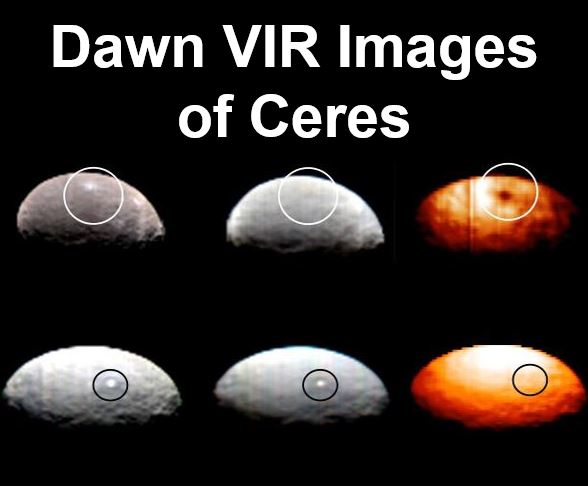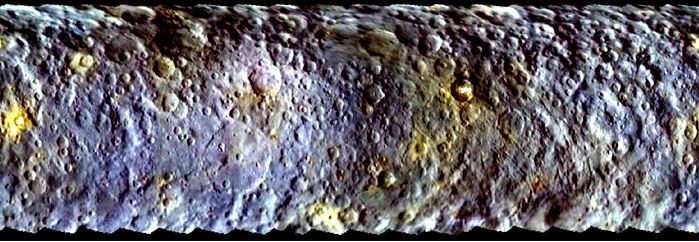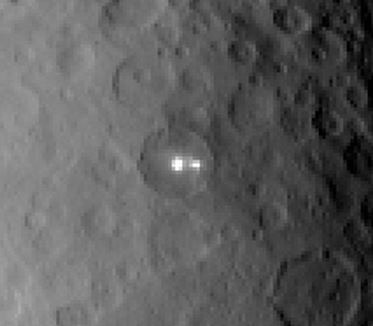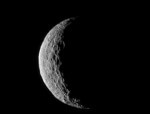The mystery of the dwarf planet Ceres started off earlier this year when two bright spots were identified next to each other in a crater 57 miles (92 kilometers) wide. Now, based on observations, planetary scientists say they have identified ten bright regions on Ceres’ surface.
The pair of bright spots, which are by far the brightest visible marks on the dwarf planet, is located in a region that is similar in temperature to its surroundings. However, another bright feature appears to be in a cooler region than the rest of Ceres’ surface.
Scientists, who have been intrigued by the bright spots, are unable to explain yet why they are there or how they were formed. Members of the public have offered a range of explanations, ranging from highly possible to bizarre.

Images from Dawn’s visible and infrared mapping spectrometer (VIR), highlighting two regions on Ceres containing bright spots. (Image: dawn.jpl.nasa.gov)
As Dawn, the space probe sent by NASA in 2007 to study two of the three known protoplanets of the asteroid belt – Ceres and Vesta – gets closer to the dwarf planet, better-resolution images will become available.
Dawn to start scientific phase soon
As from April 23rd, Dawn will start its first intensive science phase, at a distance of 8,400 miles (13,500 km) from Ceres’ surface, when more detailed pictures of the bright spots will be available, said Martin Hoffmann, a researcher from the Dawn framing camera team, based at the Max Planck Institute for Solar System Research, Göttingen, Germany.
Chris Russell, lead investigator for the Dawn mission, based at the University of California, Los Angeles, said:
“The bright spots continue to fascinate the science team, but we will have to wait until we get closer and are able to resolve them before we can determine their source.”

A map-projected view of Ceres created from images taken by NASA’s Dawn spacecraft during its initial approach, prior to being captured into orbit in March 2015. (Credit: NASA/JPL-Caltech/UCLA/MPS/DLR/IDA)
New color map of Ceres
While Dawn has been orbiting Ceres since March, a new color map of the dwarf planet is being created, which reveals the diversity of its surface.
Differences in structure and color across Ceres’ surface suggest it was once a very active body, researchers said today at the 2015 General Assembly of the European Geosciences Union in Vienna.
Russell said:
“This dwarf planet was not just an inert rock throughout its history. It was active, with processes that resulted in different materials in different regions. We are beginning to capture that diversity in our color images.”
On March 6th, 2015, the Dawn mission made history as the first spacecraft from Earth to reach a dwarf planet, and the first to orbit two extraterrestrial targets.
From 2011 to 2012, Dawn had been studying the giant asteroid Vesta, providing numerous insights about its history and geology.

Two bright spots in a large crater on Ceres’ surface. Scientists do not know what they are. (Image: NASA)
Vesta is ‘dry’, Ceres is ‘wet’
Vesta is a dry body, while Ceres is thought to consist of 25% water ice by mass. By comparing Ceres and Vesta, scientists hope to learn more about how our solar system was formed.
Although Ceres’ surface is heavily cratered, it appears to have fewer big craters than the science team had anticipated.
The VIR (visible infrared mapping spectrometer), an imaging spectrometer that examines the dwarf planet in visible and infrared light, has been examining the relative temperature of features on the surface of Ceres.
According to Frederico Tosi, a researcher from the VIR instrument team at the Institute for Space Astrophysics and Planetology, and the Italian National Institute for Astrophysics, Rome, preliminary examination suggests that various bright regions on the dwarf planet’s surface behave differently.
NASA Video – The Dawn Mission

